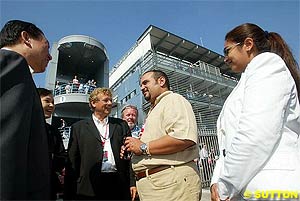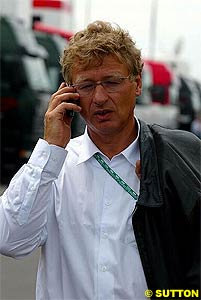
Interview with Hermann Tilke
Atlas F1 Columnist
Almost any Formula One fan has heard of Hermann Tilke, the most popular name when it comes to circuit design, and the man behind tracks like Sepang, the A1-Ring, or the new Hockenheim. Few, however, know his background or how the process of designing a new circuit is carried out. Atlas F1's Mark Glendenning talked to him to find out
MG: What was the job?
Tilke: It was a little change to a service road.
MG: That's a small beginning...
Tilke: A very small beginning. But from there it all developed, so from there I did more and more at the Nurburgring, and the next jobs were at some other, non-permanent tracks. Then I did the Sachsenring, the motorcycle circuit, then the A1-Ring, and so on. From there it just builds. Now, we have worked on at least 27 tracks. Not only doing the big things, but also working on smaller changes elsewhere and so on.
MG: How many of the Formula One tracks have you worked on now?
Tilke: I don't know! Let's count … it is Malaysia, it is Shanghai, it is Bahrain, A1-Ring, Norisring, Hockenheim, some work on Barcelona, and also Monza.
MG: You have effectively became the first point of contact for just about anyone in the world who wants to get a circuit up and running what do you do that is different?
Tilke: It's just experience, I think. To design a circuit is a very hard, complicated thing, because you have so many functions to combine. For this, you need the experience, you need the experience to know all the different events. The circuits are not only Formula One circuits, we work on other events. And in Formula One you have a lot of different interests. You have the media, you have the teams, you have the drivers, you have the VIPs. And it goes on and on. So you have a lot of different interests, and you have to bring everything together.
Tilke: Yes. And then you have the track itself. So I think we make less mistakes, because we are experienced.
MG: So what are the processes involved? If I come to you and say, 'right, I want to build a Grand Prix circuit in my backyard', how does it all begin?
Tilke: To start with, I'd come in with some engineers and we'd look very carefully at the site. We would look at things like, how the traffic would come in. What the elevation of the site is, the topography. Where the good soil is, and where the bad soil is. What is the main wind direction? And lots of things like that. How the site is configured against the sun. A lot of things. And then we collect all this information, and we can start. It's never a white sheet of paper, never, because everywhere you go you have restrictions, you have things which you need to take into account. It's never a white sheet of paper. So then we start in a team, and what happens is that the first design that we come up with will be gone, and we change all of it again.
MG: I suppose you have to juggle a lot of people who want to have input, too. If it was an F1 track, you'd have the FIA, you'd have race organisers … how do you deal with all of that?
Tilke: It's difficult! (laughs). It's very difficult. It's just part of the job.
MG: So how many people from your company would be involved with the design of the circuit?
Tilke: My company has 120 employed engineers and architects. But sometimes we are working with more than this 120, because we get some freelancers and so on. There are some months when we are working with 150 people.
MG: Is it all done on computer?
MG: You said before that you never start with a completely blank sheet, but was Sepang the closest you came to having one?
Tilke: Well there was Sachsenring. And most of the A1 ring, too. It's on the same place as the old circuit, but it is a new circuit.
MG: Logistically, how do your projects at Bahrain and Shanghai compare? What kind of environments are you dealing with?
Tilke: At Bahrain, the ground is limestone, which is very hard. It's sand compressed over thousands of years you can't just go in and excavate it, you have to blast it, and that takes a long time. But it is good because it provides a very stable foundation upon which you can build the track. Shanghai is the opposite. It's very soft, swampy soil that is sometimes up to 300m deep. So the whole track stands on 14,000 concrete piles, and each pile is between 40 and 80 metres deep. But you can't just build straight onto the piles, because it would be too heavy and they would sink. So we filled it up with polystyrene. It comes in 1mx1mx2m blocks, and is up to 14m high in some parts of the track. We bought 350,000 cubic metres of polystyrene to complete the job -- the entire Asian polystyrene market was emptied for two years! The technology comes from Norway they use it there to build railroads through fjords.
MG: Is it harder to start from scratch than to make extensive modifications to a new circuit?
Tilke: You have some advantages and some disadvantages. It's just different.
MG: When you are revising an existing circuit, I suppose you are always going to be exposed to criticisms from people who will say that the old track was better. How do you respond to that?
Tilke: What shall I say about this? You have so many things to take into account while designing. There are so many restrictions in the area that you get, you have so many other things. And at the end, it has to create good races, interesting races. The most important thing is that it has to be good for spectators, and the second is that it has to be good for the drivers (laughs). But you cannot keep looking back. The old days are the old days, and now we have other things to think about, things like safety and so on. If you take a modern track and put the guard rails right on the edge of the road, it looks different. People say, 'woah, what's that?' It's just not possible.
MG: It's interesting that when there is a boring race, people often blame the circuit.
MG: If there's a common feature of the newer F1 tracks, it is that they are relatively flat. Why is that?
Tilke: It's just because of where we have to build them. Having really flat circuits is not our ideal - I like to have some hills. Shanghai is very, very flat, but we have built some small hills into the track -- artificial ones. They are not very big, because it would not fit in with the surrounding environment, and would not be possible on that soil.
MG: Is there a common idea or philosophy behind your circuits? Something that makes them stand out as a Tilke circuit?
Tilke: No. Each project is different.
MG: Do you have a personal favourite section of any of your circuits?
Tilke: The Nordschleife on the Norisring (laughs). That's from the old days. But no favourites from the tracks that I have drawn.
Mark Glendenning: How do you get started in something like circuit designing? Was it something you wanted to do right from the start, or did you fall into it?
 Hermann Tilke: No, it did not happen by accident. I drove in races from when I was 18 (in the ETCC), and after that I studied. When I finished studying I worked as an engineer, and a short time later I founded my own company. Then I wanted to do something at a race track, so I tried hard to get some jobs, first at the Norisring, because it's close to my home town, Aachen. And I succeeded there I was only doing very small things … I was paid 600 German Marks for my first job.
Hermann Tilke: No, it did not happen by accident. I drove in races from when I was 18 (in the ETCC), and after that I studied. When I finished studying I worked as an engineer, and a short time later I founded my own company. Then I wanted to do something at a race track, so I tried hard to get some jobs, first at the Norisring, because it's close to my home town, Aachen. And I succeeded there I was only doing very small things … I was paid 600 German Marks for my first job.
 MG: Plus you have to deal with the physical constraints of where you are working; the topography and so on...
MG: Plus you have to deal with the physical constraints of where you are working; the topography and so on...
 Tilke: No, the first sketches are done by hand. And then it goes into the computer, and no more is done by hand after that.
Tilke: No, the first sketches are done by hand. And then it goes into the computer, and no more is done by hand after that.
 Tilke: Yes. And sometimes it is because of the track. However the track can be really interesting, but if the fastest driver is up at the front then we need to see what the other drivers can do (to make the race interesting).
Tilke: Yes. And sometimes it is because of the track. However the track can be really interesting, but if the fastest driver is up at the front then we need to see what the other drivers can do (to make the race interesting).
Please Contact Us for permission to republish this or any other material from Atlas F1.
|
Volume 10, Issue 01
Articles
Williams Launch: Reading Between the Lines
Ugly is Beautiful for Williams
Technical Analysis: Dissecting the Walrus
Interview with Hermann Tilke
2004 Countdown: Facts & Stats
Columns
The Fuel Stop
On the Road
Elsewhere in Racing
> Homepage |